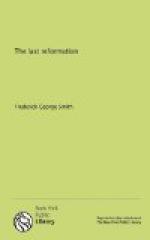[Sidenote: Original bond of union]
The bonds which united primitive Christians in one body were essentially moral and spiritual. Christ was their ever-living and ever-acting head. Their life proceeded from him, and they were all one in him. While those living in widely separated districts consulted together concerning matters of general concern, or united in cooperative efforts to accomplish common tasks, there is not the slightest evidence that there was an external human organization of the primitive church—either sectionally, nationally, or universally—centralized under a human headship of the administrative, legislative, and judicial kind. Christ was the head of the general church, the head of all the local churches, the head of all the individual members of the church. In him, the source of their common life, the primitive Christians were essentially one, and by his Spirit he operated in all hearts, in all the individual churches, and in all the ministers whose particular gifts and qualifications fitted them for divinely appointed oversight, both local and general. By this means the primitive church was able to perform the work of Christ harmoniously and present to the world the grand spectacle of one body.
[Sidenote: First steps to ecclesiasticism]
Jesus taught the humble equality of the New Testament ministry. “All ye are brethren” (Matt. 23:8). According to the New Testament they were all of one general order or rank, although greatly diversified in gifts and qualifications and the kind of work accomplished by each. The first example we have in Scripture of positional authority in the ministry as distinguished from the authority of the Holy Spirit, is the case of Diotrephes, of whom the apostle John wrote in his third epistle. We are also informed as to the nature of the authority exercised by him and the direction in which it led. It was human authority, something additional and foreign to the authority and government through the Holy Spirit, and the first example of church government by a single man. It proceeded from the evil root of pride and ambition, the love of “preeminence” among the brethren; and this usurped power and authority led to a judicial process by which innocent brethren were ‘cast out of the church.’
What a contrast this presents to that New Testament picture of the divine ecclesia, exhibiting the highest form of human society known to history, a body in which every member had his gift and use for it. Among these many activities, oversight and preaching had their place, but did not constitute the whole sum of Christian service. Paul describes Christ as the living head “from whom the whole body fitly joined together and compacted by that which every joint supplieth, according to the effectual working in the measure of every part, maketh increase of the body unto the edifying of itself in love” (Eph. 4:16). The object of the ministerial function was “the perfecting of the saints, unto the work of ministering, unto the building up of the body of Christ” (verse 12, R.V.).




